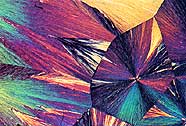|
Projection crystallography by Alan PomplunThe birefringent properties of many crystalline substances can create vivid collages when combined with polarized illumination. High magnification photographs of these patterns can be produced simply without the use of a microscope or other expensive equipment. The technique involves projecting an enlarged crystal pattern with a condenser enlarger onto 35mm film. Triphenylmethane crystals exposed for 1/2 second at f/8, 8X magnification. The only materials needed that you may not have in your darkroom are microscope slides and cover glass, and some inexpensive sheet polarizing material. These items are readily available from hobby suppliers such as Edmund Scientific Co. for less than $20. Good candidates for polarized crystallography include photographic developers, citric acid, and vitamin C. The example shown here was created with triphenylmethane. These and other chemicals are available from most laboratory supply companies. The Kodak publication, Photography Through the Microscope, P-2 (now out of print) is an excellent reference for subject selection and preparation. Each specimen was prepared by placing a small amount on a microscope slide, melting the crystals with a butane lighter held underneath, and placing a cover glass on the melted liquid. The rate of cooling affects the crystal growth and resulting patterns. The specimens can be allowed to cool slowly or the rate of crystallization can be increased by using a can of compressed air. Some chemicals may give off harmful fumes when heated, so always prepare the specimens under a range hood with adequate ventilation. Once prepared, the slide is taped onto the 35mm negative/carrier of a condenser enlarger. The sheet polarizing material is cut to fit in the enlarger filter drawer, between the lamp and condenser lenses. A glass polarizing filter normally used on a camera lens is placed in the filter holder beneath the enlarging lens. This filter is rotated to block light which is unaffected by the crystals and produces images with maximum color saturation. A 35mm SLR camera is placed on its back on a small box or piece of wood to provide clearance for the film advancelever from the enlarger baseboard. The camera should be secured to the support with masking tape. The camera lens is removed and the enlarged crystal pattern is projected directly onto the film during exposure. A camera with a removable prism viewfinder works best, as it allows focusing directly through the groundglass. If your camera s viewfinder is not removable, lock the shutter open and focus the image directly on the film and then advance the film one frame before making exposures. Exposure times can be determined with manual or automatic in-camera metering. An enlarging lens aperture of f/8 or larger should be used to minimize diffraction effects. It is essential to mask the area of the specimen which is not to be included in the image to reduce flare and maintain image contrast. Rectangular masks made from thin cardboard can be laid directly on top of the slide. To make exposures, use the camera’s self timer or lock the shutter open and use the enlarger timer to control exposure time. Either tungsten or daylight balanced film can be used, although daylight film provides warmer tones which usually complement the images. Color correction filters can also be used to alter the color balance of the images. I often use an 82B filter when producing these images, all of which are usually made on Kodachrome 64 film in a Nikon F2 camera body. A Beseler 23CII-XL enlarger with a 50mm El-Nikkor lens was used to project the image shown here. Magnifications from 3X to 15X are possible for both the image recording and printing steps, resulting in print magnification of 200X or more, depending upon print size and enlarger capability. A note of caution: The camera must be centered directly below the enlarger lens for exposures, or vignetting will occur, as the film plane is recessed in the camera body. Several variations of this crystallography technique are possible. The images can be projected directly onto reversal printing papers such as Cibachrome and Ektachrome to produce first generation prints. 4x5 film in a standard holder can be placed on the enlarger baseboard in place of the 35mm camera to produce larger negatives or transparencies. Using a dichroic color enlarger will provide for selective color control through variable filtration. This enlargement technique can be applied to other transparent or translucent subjects such as biological specimens and paper or linen samples. An English Ivy leaf and a twenty dollar bill were photographed with Ektachrome EPY film using the projection enlargement technique. The polarizers are omitted when photographing these non-birefringent subjects. An incredible variety of images can be created with the projection method. Beautiful high magnification polarized crystal images can be produced by any photographer with an enlarger and the ambition to explore these fascinating subjects. reprinted from: INDUSTRIAL PHOTOGRAPHY - MAY 1988 Alan R. Pomplun studied projection crystallography as a student in the Imaging and Photographic Technology program at Rochester Institute of Technology. He is now working for the Sandia National Laboratories, Livermore CA.
If you would like to discuss this project with Alan's instructor at the time, I would be happy to provide whatever assistance is needed. Contact Andrew Davidhazy at RIT, 70 Lomb Memorial Drive, Rochester, NY 14623. Phone 585-475-2592, fax 585-475-5804 ... but the fastest way is to just send me e-mail at andpph@rit.edu
|
